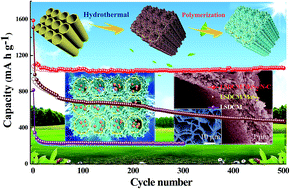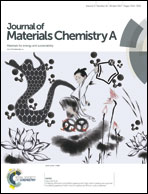Novel carbon channels from loofah sponge for construction of metal sulfide/carbon composites with robust electrochemical energy storage†
Abstract
Directional construction of highly active electrode materials plays a critical role in innovations in energy storage. One effective route to these materials is to imitate biological structures in nature. In this work, for the first time, we report the template functionability of carbon tube channels from loofah sponge. Hydrothermal MoS2 nanosheets and polymerised N-doped carbon (N-C) are rationally assembled on loofah sponge-derived carbon microtubes (LSDCM), forming ternary sandwiched composites. Due to the smart design and unique porous ternary structure, the as-prepared LSDCM/MoS2/N-C composites exhibit significantly enhanced lithium/sodium storage properties including highly reversible capacity, superior rate capability and excellent capacity retention (1058 mA h g−1 for lithium storage after 500 cycles and 534 mA h g−1 for sodium storage after 100 cycles at 0.2 A g−1). Our research not only demonstrates a novel high-quality carbon template/matrix, but also provides a new electrode design protocol for the construction of advanced metal sulfide-based electrodes for applications in electrochemical energy storage and electro-catalysis.



 Please wait while we load your content...
Please wait while we load your content...